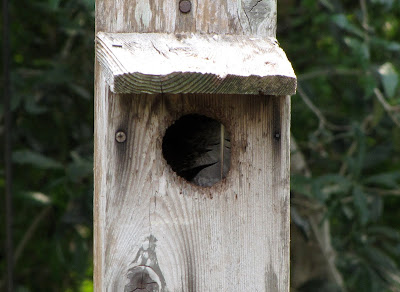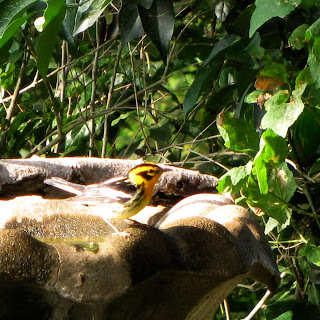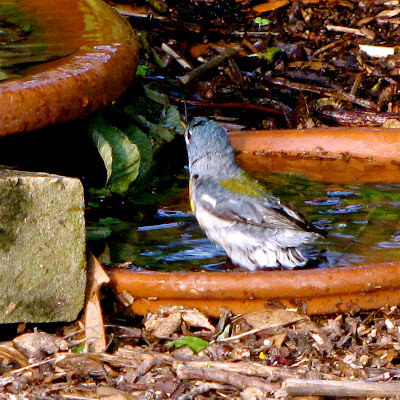May is not only a month of migration in the yard, but also a bustling, interesting time to observe the "ordinary" year-round residents and summer nesters that are easily overlooked when so many warblers and tanagers and other bright migrants distract us.
Of course, these birds are not really ordinary at all. For example, nothing beats a Buff-bellied Hummingbird for beauty and spunk. This one, perched in a patch of sunlight, is as lovely as any bird could be. We are so lucky to have multiple buff-bellieds living here in ourTexas Rio Grande Valley yard. I've been looking for their nest--I'm certain there's one in the yard --but the nests are so tiny, I haven't found it yet.
 |
| an unfinished Altamira Oriole nest |
Some of our yard nests are more obvious than others. The Altamira Orioles, for example, build a nest that cannot be ignored. It hangs down, sometimes two feet long, from a branch high on the northwest side of an oak or ash or cedar elm tree. A busy pair of the orioles might build one nest and then, because of nervousness about the Bronzed Cowbirds that wait for a chance to lay eggs in the nest, or just fickleness about where they want to live, abandon it and build another.
That's what happened again this year. A pair worked for several days and defended their nest from the cowbirds and even other Altamiras--and then left it to be blown apart by the wind. I don't know where the new nest is, but it's somewhere close by--maybe in the neighbor's Tepehuaje tree or maybe across the Arroyo. I haven't gone looking for it yet. The orioles still eat oranges and seed from the feeders many times a day, but I'm disappointed that they abandoned the nest they built in one of our oak trees.
 The last day I saw the birds at their abandoned nest was the day I took the picture on the right. It was a spat between a first-year bird and one of the two older (more orange) Altamiras that had built the nest. These are not usually fussy or aggressive birds (though they do join in on the mobbing of the screech-owls), so I was surprised to see them tumbling onto the neighbor's driveway below the nest.
The last day I saw the birds at their abandoned nest was the day I took the picture on the right. It was a spat between a first-year bird and one of the two older (more orange) Altamiras that had built the nest. These are not usually fussy or aggressive birds (though they do join in on the mobbing of the screech-owls), so I was surprised to see them tumbling onto the neighbor's driveway below the nest.Brown-crested Flycatchers started a nest in a birdhouse in the butterfly garden. They put a large gray feather in the box that can be seen in the entry hole. Not all cavity-nesting birds put nesting materials in their nest cavities (the screech-owls don't; I don't think our Golden-fronted woodpeckers do--both just lay eggs on the floor that is sprinkled with wood shavings or sawdust from the excavation, if it's a natural cavity, or that we have put in there if it's a man-made box).
BC Flycatchers put all kinds of things in their nests: feathers, snakeskins, grass, bark. They usually have three broods, building a new nest in a different location each time. At least that's what they've done in our yard.
 |
| Brown-crested Flycatcher nest: note the extra-large feather! |
Brown-crested Flycatchers are not year-round residents here. They arrive in March or April and raise several broods. Unfortunately, some of the eggs hatch baby cowbirds. See this post for photos of last year's feeding frenzy when they had hungry young ones.
Carolina Wrens are year-round residents. This one is grooming itself while taking a break from its nestlings that were snuggled in a hanging artificial plant on my neighbor's porch. Wrens love to nest in man-made things: pots, plants, even one time the pocket of a pair of pants another neighbor had hung on his porch railing!
I don't know where the Black-crested Titmice built their first nest this year, but four just-fledged titmice had lots of fun with their parents at the bird baths this morning.
The young ones have crests that are more gray than black, making them look like the closely-related Tufted Titmice that live further north.
These guys win the prize for strange nesting places. Last year they nested in a cow's skull that decorates the neighbor's storage house. Other times they have nested inside metal posts on the boat trailer and the satellite dish. Wherever these little guys nested this time, they are now out of the nest and all over the yard. I think they win the award for cutest babies in the yard so far this year.
A few years ago the cute baby award went hands-down to the Plain Chachalaca chicks. Precocial, they are out of the nest on the day they are born and soon are chasing around after the adults. (If a bird is altricial, it is born naked and helpless and stays in the nest for a while. By the time it is out of the nest, it's hard to tell an adult bird from a young one.)
 |
| adult Plain Chachalaca in a Wild Olive tree |
I've been hearing a Chachalaca chorus every morning for a week or so, but I'm sure they won't nest in our yard since neighbors on both sides have outdoor cats that are too much of a danger to the little chicks. Before cats lived so close, these interesting birds nested in the Anacua tree beside the driveway.
 |
| Clay-colored Thrush |
Award for the most exciting bird in the yard today goes to the Clay-colored Thrush that sang all morning long from the tops of several trees. We have never had a nesting pair, though we occasionally see them in the winter. Until a few years ago (when they were called Clay-colored Robins) they were very rare in the US. Now they nest in several locations in the Rio Grande Valley--but until now not in our neighborhood. The song is beautiful (similar in tone to an American Robin) and I would love to have these birds be summer nesting residents.
As long as we're handing out awards, Cutest Couple would definitely go to the Inca Doves, one of six species of doves that nest in the neighborhood. (Other doves that are year-round residents are Mourning, White-winged, White-tipped, Common Ground Dove, and Eurasian Collared-dove.)
The most endearing thing Inca Doves do while courting (in addition to snuggling, grooming, and cooing a soft whirl-pool, whirl-pool) is raise their wings to show the soft pink underneath. This guy raises his left wing;
whereupon his mate raises her right.
No spring migrating warbler, tanager, nor even Painted Bunting can rival one of our resident birds for sheer beauty: the Green Jay wins Most Beautiful no matter what the competition.
Green Jays are not building their nest in our yard this year, but they are gathering nesting material here.
Look closely (or enlarge with a click) and you'll see this Green Jay has a twig grasped in his feet. He seems to be shaping it so that it will fit the nest he is building close by.
He holds it with his feet and shapes it with his beak.
When it's to his liking he takes it in his beak and flies away to the west where his nest is. A pair of Green Jays spent one afternoon flying back and forth from our yard to one a few yards over where I presume they are building the nest in a native tree or shrub. I can't wait until they fledge a family of lively jays that will decorate the yard later in the summer. Last year's Green Jay family was unrivaled in beauty and joyous antics. (See this post from last summer for the jay family doing the Green Jay dance.)
Spring migration, which was certainly spectacular this year, is drawing to a close. The colorful parade of birds that thrill us because of the brief time we have with them may be over for the year, but the fun of watching our yard will continue as it does every summer. I can't imagine living in a better place for backyard birdwatching. Living here makes me feel as though I've won first place in the birders' sweepstakes.
Spring migration, which was certainly spectacular this year, is drawing to a close. The colorful parade of birds that thrill us because of the brief time we have with them may be over for the year, but the fun of watching our yard will continue as it does every summer. I can't imagine living in a better place for backyard birdwatching. Living here makes me feel as though I've won first place in the birders' sweepstakes.

















































